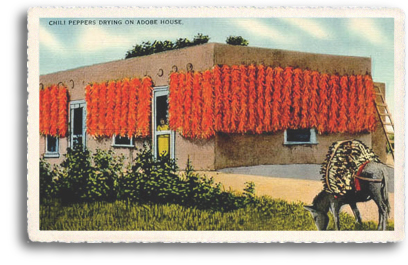 |
||
 All About Chili All About ChiliRed or Green? The New Mexico official state question is: “Red or Green?” And, of course, it’s a reference to chili, chili, chili! When placing an order at any New Mexican restaurant or take out stand there’s no doubt you’ll be asked that question. And it is for good reason: there’s a vast difference in the taste of red and green chilis and the overall flavor it will add for a dish. Chili is the state’s largest locally grown crop. After processing, New Mexico’s chili crop is valued at nearly $250 million per harvest. And while the popularity of hot, spicy food has spread throughout the country, the hot, hot chili has been a staple of New Mexico cooking for centuries. History of Chili Chili is one of the world’s oldest spices. Its origins can be traced to the Amazon region of South America. Although it is unclear how and when chili actually made its way to New Mexico, references to chili in the region date back to the 1500s. Some credit its arrival to Juan de Oñate, the Spaniard who founded Santa Fe in 1609, while others think chili was introduced earlier to the Pueblo Indians by the Spanish on their travels north from Mexico. Then there is the belief that chili grew wild in New Mexico many centuries before the Spanish arrived. Regardless, chili is now grown all over the state, with Hildago, Luna and Doña Ana counties topping the state’s chili production. New Mexico is the leading producer of “pungent” chili in the United States What Is Chili? The pungency or “heat” of chili comes from a substance called capsaicin, which is contained in the seeds of the chili. There are many types of chili and each has a differing level of heat. This is sometimes affected by the environmental factors of the area in which it is grown, such as the temperature and amount of water available. The Scovile Heat Unit Scale The hotness of any particular chili can be determined by the Scovile Heat Unit Scale. For example, on this scale the bell pepper is rated zero as it has no heat, while the jalapeño pepper is rated 5,000. The average New Mexico chili is rated 5,000, comparable to the jalapeño. Back to the official state question, red and green chilis come from the same plant. Red chili is simply riper than its green brother. In general, red is milder than green, but its advisable to ask your server which type is hotter. Forms of Chili It’s easy to spice up your food with the taste of chili. Red chili can be purchased in powder form in mild, medium or hot. Chili powder combined with a few other simple ingredients is the basic “hot sauce” that is widely available both in New Mexico and around the world. Red and green chili sauce is a great condiment to add a taste of New Mexico to almost any dish. Chili is sold worldwide fresh, dried and powdered. In the United States, it is often made from the Mexican “chile ancho” variety, but with small amounts of cayenne added for heat. In the Southwest U.S., dried ground chili peppers, cumin, garlic and oregano is often known as “chili powder.” Chipotles are dry, smoked red (or ripe) jalapeños. Chili peppers are used around the world to make a countless variety of sauces, known as hot sauce, chile sauce, or pepper sauce. The Spelling of Chili The three primary spellings of this plant are: chili, chile and chilli, all of which are recognized by dictionaries. • “Chili” is widely used, although in much of South America the plant and its fruit are better known as ají, locoto, chile, or rocoto. However, this spelling is discouraged by some in America, since it also commonly refers to a popular Southwestern American dish (also known as chili con carne, literally “chili with meat”). Chili powder and chile powder, on the other hand, can both refer to dried, ground chili peppers. • “Chile” is an alternate usage, the most common Spanish spelling in Mexico, as well as some parts of the United States and Canada, which refers specifically to this plant and its fruit. In the American Southwest (particularly northern New Mexico, chile also denotes a thick, spicy, un-vinegared sauce, which is available in red and green varieties and which is often served over most New Mexican cuisine. • “Chilli” was the original and preferred British spelling. This spelling is discouraged by some, since it would be pronounced differently in Spanish, into which it was first Romanized. Back to Taos Unlimited Back to Santa Fe Unlimited |
||
Home | Food | Lodging | Merchants | Services | Real Estate | Art & Galleries | Entertainment | Recreation Ski Areas | Mind-Body-Spirit | Taos Information | Local Color | Taos Pueblo | High Road to Taos | Taos Plaza | Ranchos de Taos Scenic Beauty | Day Trips | Chili | Special Events | Taos History | Multicultures | Museums | The Enchanted Circle The Wild West | Taos Art Colony | Plants & Wildlife | Counterculture | Turquoise | Architecture | Features | About Us | Get Listed! Taos Unlimited Trading Post | Photo of the Week | Link of the Month | Taos Webcams | Taos Weather | Testimonials | Guestbook Taos A to Z | Movie Locations | Sitemap | Taos Unlimited Blog | Aimee & Jean's Story Blog | Contact Us | Santa Fe Unlimited |
||